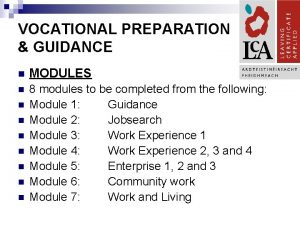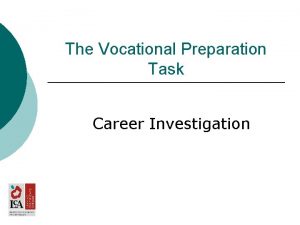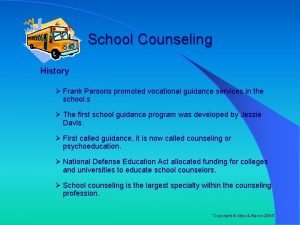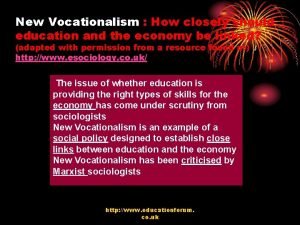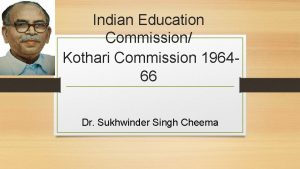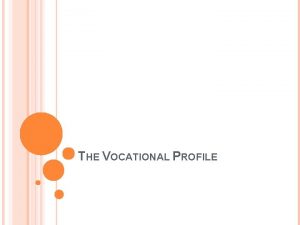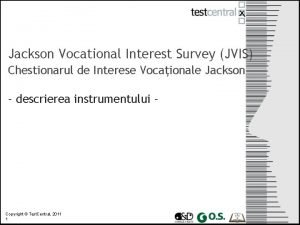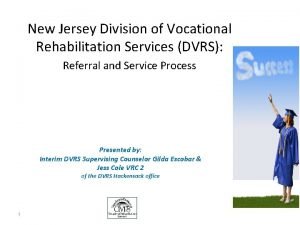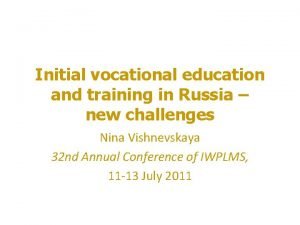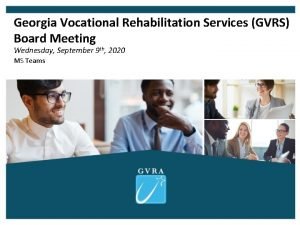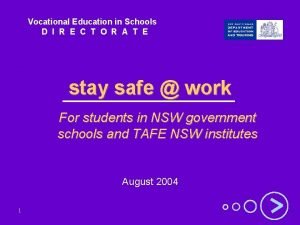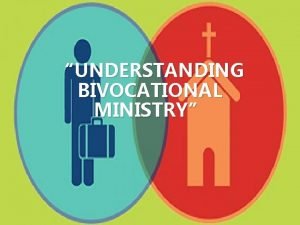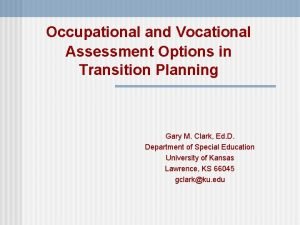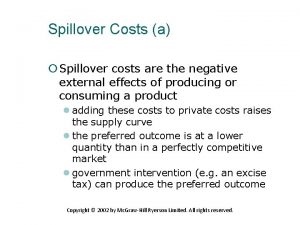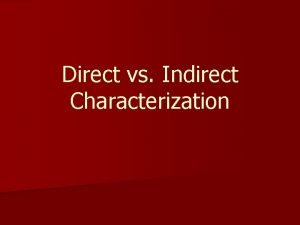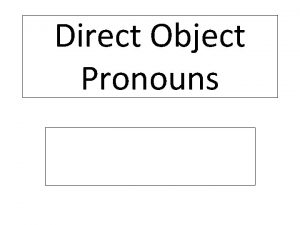LONGTERM DIRECT AND SPILLOVER EFFECTS OF VOCATIONAL TRAINING







































- Slides: 39

LONG-TERM DIRECT AND SPILLOVER EFFECTS OF VOCATIONAL TRAINING Adriana Kugler, Georgetown & NBER Maurice Kugler, IMPAQ Juan E. Saavedra, USC Luis Omar Herrera, IDB

Motivation Vocational training is aimed at improving employment prospects for individuals with difficulty integrating into the economic mainstream. Many rigorous randomized evaluations of vocational training in the U. S. , including evaluations of CETA, JTPA, NSW Demonstration, and WIA show moderate effects of vocational training in the U. S. However, up until recently, no evaluations had been done for low- and middle-income countries.

Motivation In Attanasio, Kugler and Meghir (AKM, 2011), we evaluated Youth in Action (Yi. A), a training program targeted to disadvantaged youth in Colombia. One of the few randomized training trials in a developing country. Found large labor market returns for women in the short-run. Simultaneously, Card et al. (2011) evaluated Juventud y Empleo in the Dominican Republic and found similar, though less precise, effects.

This Paper We go beyond AKM (2011) using uniquely good data: 1. Medium- and long-term effects of training up to 8 years after random assignment. 2. Explore effects on other outcomes - substitutability or complementarity between vocational training and formal education – do “skills beget skills”? 3. External effects of vocational training relatives - beyond those typically examined in the literature.

This Paper We examine long-term education and labor market impacts for both applicants to Yi. A and their relatives. We look at penumbra effects beyond the short-term direct labor mkt. effects of participants. Widespread effects of what was introduced as a narrow intervention. This project uses uniquely good data. We combine original baseline Yi. A data with national administrative education and social security records.

Plan for Rest of the Talk 1. Program background & prior evidence 2. Data 3. LR Formal Education Impacts on Participants and Relatives 4. LR Labor Market Impacts on Participants and Relatives 5. Conclusions

Description of the Program + In late 1990 s, Colombia was hit by the hardest recession in 60 years. In 2001 the government introduced 3 emergency social programs: Families in Action, Employment in Action and Youth in Action. + Youth in Action reached 80, 000 young people during the years 2002 -2005. This paper analyzes the last cohort, which randomized individuals into the program. + Program targeted people b/w 18 -25 years of age, who were unemployed and whose families were in the lowest two deciles of the income distribution living in the 7 largest cities of the country.

Description of the Program Yi. A program: 3 months classroom training and 3 of OJT. Classroom training provided by training institutions, which had to be legally registered, show financial solvency and compete in a bidding process. In 2005, there were 114 training institutions. On-the-job training was provided by legally registered companies. Pay-for performance system as training institutions only paid if placed students into OJT. Participants received a stipend of $2. 20 per day and women with children under 7 years of age received a stipend of $3. 00 per day to help cover for childcare.

Randomization The randomization worked as follows: Ø Each class in each training institution provided a list of up to 50% more applicants than they had capacity for. Ø On January 18 th, individuals in the list were randomly offered or not offered a position in a class at each training institution. In practice, there was close to full compliance from the workers side. In our sample, only 0. 18% of those offered training turned it down and only 1. 29% of those put in the back-up lists got trained.

Randomization

Short-term Impacts of YIA (AKM 2011) One year after the lottery, training offer increased the probability of paid employment by 7 pp and earnings by 20 percent among women. No short term labor market effects among men. Formal employment increases for both women and men of 7 pp and 6 pp, respectively.

Data 1. Baseline data for a sample of 3, 954 training applicants from 2005 cohort and follow-up Survey. Sample selection stratified by treatment offer, city and gender. 2. Social Security Records with information on social security contributions Years 2008 -2013.

Data 3. National administrative secondary school completion exam records (ICFES). Years 2000 -2012. 4. National administrative tertiary education database (SPADIES). Years 1998 -2013. Can use pre-2005 years as placebo tests. 5. Criminal records from the Administrative Security Department for 2010 (DAS).

Match with Administrative Data

Impacts on Formal Education of Participants Lottery winners are no more likely to graduate from secondary school than losers. However, winners are 3. 3 pp more likely to enroll in formal tertiary education after random assignment: Men in universities and women in vocational colleges. Strongest effects among applicants with aboveaverage baseline schooling.

Tertiary School Enrollment

By Type of Higher Education

Placebo Test of Higher Education

Impacts on Relatives’ Education Relatives of male lottery winners are about 1. 5 pp to finish HS. Female sisters of female lottery winners and other male and female relatives of male lottery winners are more likely to finish HS. Smaller effects of Yi. A on relatives’ tertiary school attendance, but some effects: 0. 5 pp and 0. 2 pp more likely to enroll in public university and in a public vocational school.

Relatives’ Secondary School Completion

Relatives’ Higher Ed Enrollment

Impact on Male Relatives

Impact on Female Relatives

Why Complementarity? Three potential stories: 1. Information about own abilities – unlikely, since relatives also benefit. 2. Relaxing budget constraints for household – unlikely, since effects similar or larger effect for men than women. 3. Information about value of formal education: Ø Study in same field in college as in vocational training. Ø Women participants more likely to affect women relatives and men likely to affect both, consistent with information transmission in the household.

Percent Enroll in Knowledge Area in College by Vocational Course Attended

Percent Enroll in Knowledge Area in College by Vocational Course Attended, Relatives

Impacts on Criminal Activity and Mobility

LR Effects on Formal Employment Lottery winners are still more likely to be employed in formal jobs even between 2 and 8 years after going through Youth in Action. Women and men are 5. 7 pp and 3. 8 pp more likely to be employed in formal sector jobs. Lottery winners formal sector earnings increase for women and men. Women lottery winners’ annual earnings increase by between 17% to 20% and daily earnings by 8% to 10%. Male lottery winners’ annual earnings increase by 8% and daily earnings by 5%.

Medium- & Long-term Labor Market Impacts

Comparisons of SR and LR Effects Training effects on female formal employment and earnings persist even 8 years after Yi. A. SR and LR effects of training on women’s formal employment and daily formal earnings are very similar in magnitude. For men, formal employment is persistent but earnings effects dissipate over time. The LR effect on formal employment is somewhat smaller than the SR effect, but SR men’s earnings effect are twice the LR earnings effect.

LR Labor Market Effects of Family Members We find effects on formal employment of relatives of lottery winners. By contrast, we find do no effect on other labor market outcomes of relatives, including no impacts of days worked or earnings.

Labor Market Effects of Relatives

Cost-Benefit Analysis Costs: a. Direct cost of program, b. Shorter tenure since enrolled in training & school. Benefits: a. Direct impact on participants’ higher formal sector earnings, b. Participants’ higher earnings since more educated, c. Relatives’ higher earnings of relatives due to more formal education and higher employment.

Cost-Benefit Analysis - Applicants

Cost-Benefit Analysis - Relatives

Cost-Benefit Analysis

Conclusions We use administrative data and find that labor market effects of vocational training persist for women but somewhat dissipate for men. We look at additional outcomes and find that vocational training complements formal education – vocational training encourages lottery winners to attend colleges and universities. Relatives of lottery winners also benefit by enrolling in HS and college and from higher employment.

Conclusions Looking at only most obvious outcomes may mean one misses effects altogether for certain groups: Vocational training may complement formal education, providing an avenue for social mobility. Complementarity b/w training and formal education likely due to learning about returns to education by participants and their relatives.

Conclusions Welfare calculations of programs typically based on short-term effects on basic outcomes, but other potential impacts on other outcomes and spillovers may lead to under-estimate social desirability of programs. We find that failing to account for the spillovers of this program, especially in the case of men, substantially under-estimates the internal rate of return of Yi. A and would lead to very different welfare conclusions.
 Linux kernel lts
Linux kernel lts Thomas silverstein art
Thomas silverstein art Kampa bhai vocational training institute limited
Kampa bhai vocational training institute limited Vocational education & training in uae
Vocational education & training in uae Vocational training
Vocational training Cpd pharmacy examples
Cpd pharmacy examples Technical vocational meaning
Technical vocational meaning Vocational preparation and guidance
Vocational preparation and guidance Vocational preparation task
Vocational preparation task Society vocational institute mughalpura
Society vocational institute mughalpura Definition of tech-voc
Definition of tech-voc Frank parsons counseling
Frank parsons counseling New vocationalism sociology
New vocationalism sociology Types of vocational courses
Types of vocational courses Vocational school marketing
Vocational school marketing Movie
Movie Idaho division of vocational rehabilitation
Idaho division of vocational rehabilitation Vocational subculture
Vocational subculture Examples of countercultures
Examples of countercultures Pierson vocational high school
Pierson vocational high school Vocational profile
Vocational profile Aim of secondary education
Aim of secondary education Vocational service definition
Vocational service definition Jvis
Jvis Which act first developed courses in vocational agriculture
Which act first developed courses in vocational agriculture Asvab average scores
Asvab average scores Division of vocational rehabilitation
Division of vocational rehabilitation Vocational education in russia
Vocational education in russia Chris wells gvra
Chris wells gvra Admiral peary area vocational technical school
Admiral peary area vocational technical school Vocational service
Vocational service Hazard vocational school
Hazard vocational school Bi-vocational definition
Bi-vocational definition Bvr las vegas
Bvr las vegas Tampere vocational college tredu
Tampere vocational college tredu Sra pou vocational school
Sra pou vocational school Vocational planning
Vocational planning Ict college of vocational studies
Ict college of vocational studies Ict college of vocational studies
Ict college of vocational studies Dr. charles homer lane
Dr. charles homer lane







